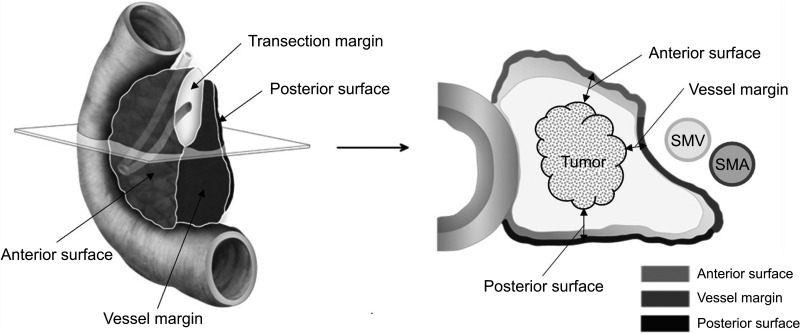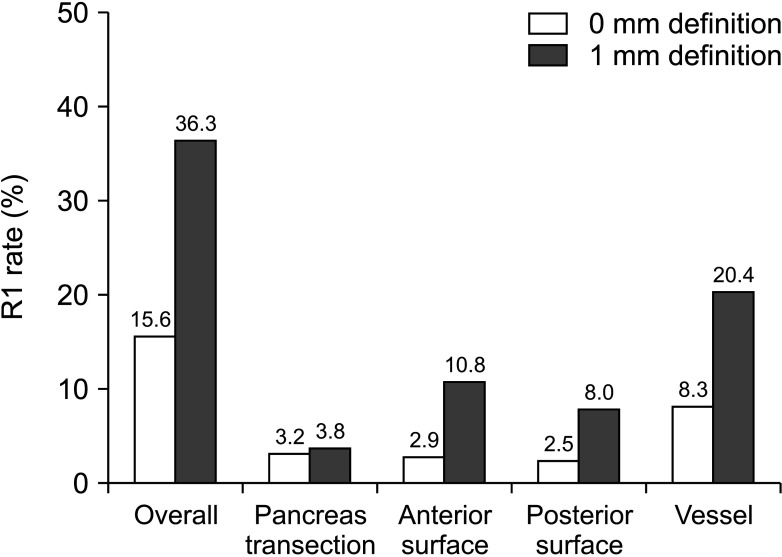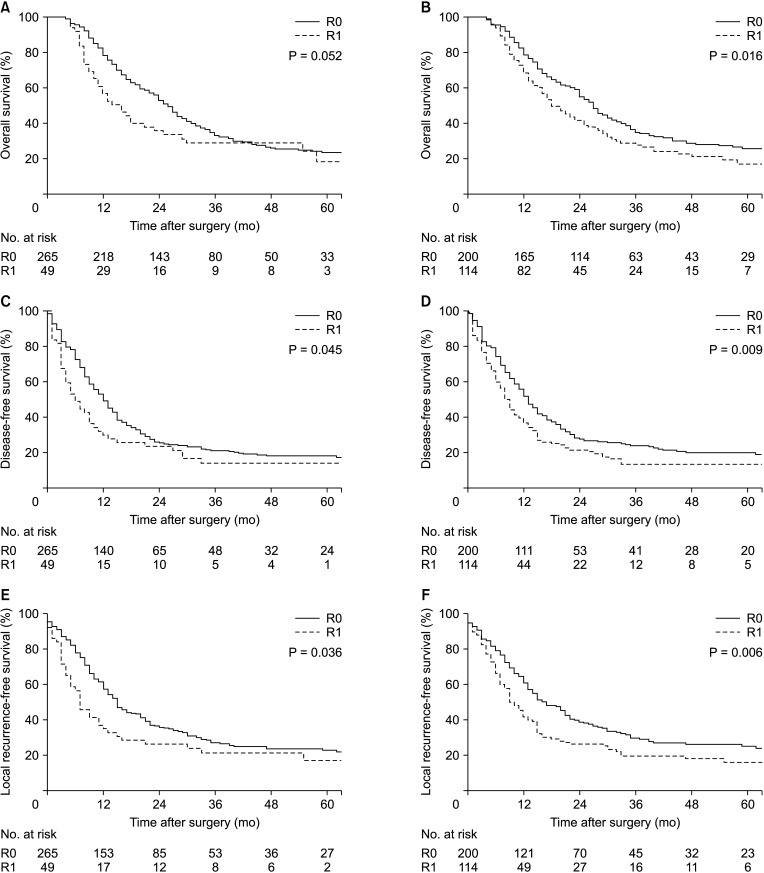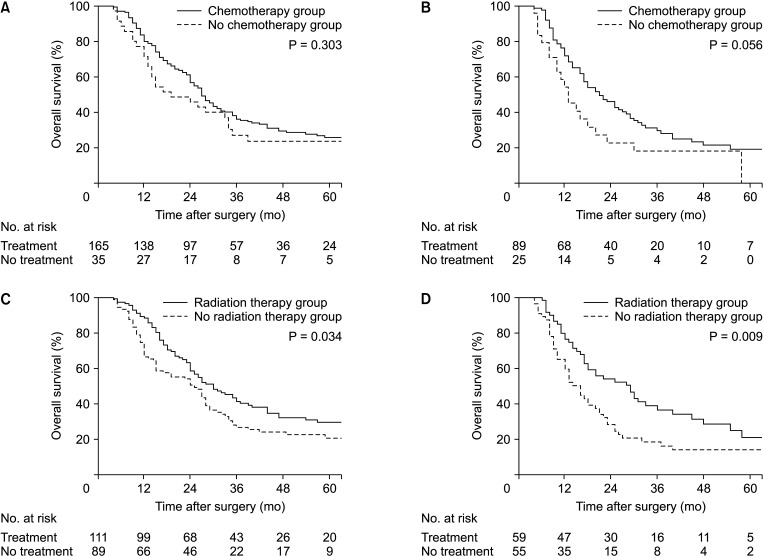Ann Surg Treat Res.
2022 Jan;102(1):10-19. 10.4174/astr.2022.102.1.10.
Oncologic outcomes according to the location and status of resection margin in pancreas head cancer: role of radiation therapy in R1 resection
- Affiliations
-
- 1Department of Surgery and Cancer Research Institute, Seoul National University College of Medicine, Seoul, Korea
- 2Department of Pathology, Seoul National University College of Medicine, Seoul, Korea
- 3Department of Radiation Oncology, Seoul National University College of Medicine, Seoul, Korea
- KMID: 2523765
- DOI: http://doi.org/10.4174/astr.2022.102.1.10
Abstract
- Purpose
The clinical significance of margin status in pancreatic head cancer is still controversial due to the nonstandardized definition of R status and pathologic reporting. This study aims to evaluate the impact of the margin status including location and the role of radiation therapy in pancreatic head cancer.
Methods
A total of 314 patients who underwent curative-intent surgery for pancreatic head cancer between 2010 and 2017 were analyzed. Demographics, survival, and local recurrences were compared according to 2 definitions: 0-mm R1 as direct involvement and 1-mm R1 as close resection margin less than 1 mm. The specific margins were divided into 4 groups according to the location around the pancreas: pancreas transection, anterior surface, posterior surface, and vessel (superior mesenteric artery/superior mesenteric vein) margin.
Results
The 0-mm R1-rate was 15.6%, and increased to 36.3% in 1-mm R1. The median overall survival rate of 0-mm R0 vs. R1 was 26 months vs. 16 months (P = 0.052) and that of 1-mm R0 vs. R1 was 27 months vs. 18 months, respectively (P = 0.016). In individual margins, posterior, anterior surface, and pancreas transection margin involvement were associated with poor outcome, and the 1 mm posterior surface involvement was an independent risk factor for disease-free survival (hazard ratio, 1.63). Adjuvant radiation therapy had oncologic benefits, especially in R1 patients (P = 0.011) compared to R0 patients (P = 0.088).
Conclusion
Margin status, especially 1-mm R1 status is an important predictive factor, and involved posterior surface has a clinical impact. Patients with positive margins should be considered adjuvant radiation therapy.
Keyword
Figure
Reference
-
1. Schnelldorfer T, Ware AL, Sarr MG, Smyrk TC, Zhang L, Qin R, et al. Long-term survival after pancreatoduodenectomy for pancreatic adenocarcinoma: is cure possible? Ann Surg. 2008; 247:456–462. PMID: 18376190.2. Oettle H, Neuhaus P, Hochhaus A, Hartmann JT, Gellert K, Ridwelski K, et al. Adjuvant chemotherapy with gemcitabine and long-term outcomes among patients with resected pancreatic cancer: the CONKO-001 randomized trial. JAMA. 2013; 310:1473–1481. PMID: 24104372.3. Yamamoto T, Yagi S, Kinoshita H, Sakamoto Y, Okada K, Uryuhara K, et al. Long-term survival after resection of pancreatic cancer: a single-center retrospective analysis. World J Gastroenterol. 2015; 21:262–268. PMID: 25574100.
Article5. Chang DK, Johns AL, Merrett ND, Gill AJ, Colvin EK, Scarlett CJ, et al. Margin clearance and outcome in resected pancreatic cancer. J Clin Oncol. 2009; 27:2855–2862. PMID: 19398572.
Article6. Kim BH, Kim K, Jang JY, Kwon W, Kim H, Lee KH, et al. Survival benefit of adjuvant chemoradiotherapy for positive or close resection margin after curative resection of pancreatic adenocarcinoma. Eur J Surg Oncol. 2020; 46:2122–2130. PMID: 32782200.
Article7. Adsay NV, Basturk O, Saka B, Bagci P, Ozdemir D, Balci S, et al. Whipple made simple for surgical pathologists: orientation, dissection, and sampling of pancreaticoduodenectomy specimens for a more practical and accurate evaluation of pancreatic, distal common bile duct, and ampullary tumors. Am J Surg Pathol. 2014; 38:480–493. PMID: 24451278.8. Ethun CG, Kooby DA. The importance of surgical margins in pancreatic cancer. J Surg Oncol. 2016; 113:283–288. PMID: 26603829.
Article9. Hruban RH, Pitman MB, Klimstra D. Tumors of the pancreas. AFIP Atlas of tumor pathology. Washington, DC: Armed Forces Institute of Pathology;2007.10. Campbell F, Bennett M, Foulis AJ. Minimum dataset for histopathological reporting of pancreatic, ampulla of vater and bile duct carcinoma. London: Royal College of Pathologists;2002.11. Chandrasegaram MD, Goldstein D, Simes J, Gebski V, Kench JG, Gill AJ, et al. Meta-analysis of radical resection rates and margin assessment in pancreatic cancer. Br J Surg. 2015; 102:1459–1472. PMID: 26350029.
Article12. Schlitter AM, Esposito I. Definition of microscopic tumor clearance (r0) in pancreatic cancer resections. Cancers (Basel). 2010; 2:2001–2010. PMID: 24281214.
Article13. Ghaneh P, Kleeff J, Halloran CM, Raraty M, Jackson R, Melling J, et al. The impact of positive resection margins on survival and recurrence following resection and adjuvant chemotherapy for pancreatic ductal adenocarcinoma. Ann Surg. 2019; 269:520–529. PMID: 29068800.
Article14. Strobel O, Hank T, Hinz U, Bergmann F, Schneider L, Springfeld C, et al. Pancreatic cancer surgery: the new R-status counts. Ann Surg. 2017; 265:565–573. PMID: 27918310.
Article15. Butturini G, Stocken DD, Wente MN, Jeekel H, Klinkenbijl JH, Bakkevold KE, et al. Influence of resection margins and treatment on survival in patients with pancreatic cancer: meta-analysis of randomized controlled trials. Arch Surg. 2008; 143:75–83. PMID: 18209156.16. Tummers WS, Groen JV, Sibinga Mulder BG, Farina-Sarasqueta A, Morreau J, Putter H, et al. Impact of resection margin status on recurrence and survival in pancreatic cancer surgery. Br J Surg. 2019; 106:1055–1065. PMID: 30883699.
Article17. Verbeke CS, Leitch D, Menon KV, McMahon MJ, Guillou PJ, Anthoney A. Redefining the R1 resection in pancreatic cancer. Br J Surg. 2006; 93:1232–1237. PMID: 16804874.
Article18. Gill AJ, Johns AL, Eckstein R, Samra JS, Kaufman A, Chang DK, et al. Synoptic reporting improves histopathological assessment of pancreatic resection specimens. Pathology. 2009; 41:161–167. PMID: 19320058.
Article19. Jamieson NB, Foulis AK, Oien KA, Going JJ, Glen P, Dickson EJ, et al. Positive mobilization margins alone do not influence survival following pancreatico-duodenectomy for pancreatic ductal adenocarcinoma. Ann Surg. 2010; 251:1003–1010. PMID: 20485150.
Article20. Delpero JR, Bachellier P, Regenet N, Le Treut YP, Paye F, Carrere N, et al. Pancreaticoduodenectomy for pancreatic ductal adenocarcinoma: a French multicentre prospective evaluation of resection margins in 150 evaluable specimens. HPB (Oxford). 2014; 16:20–33. PMID: 23464850.
Article21. Verbeke CS, Knapp J, Gladhaug IP. Tumour growth is more dispersed in pancreatic head cancers than in rectal cancer: implications for resection margin assessment. Histopathology. 2011; 59:1111–1121. PMID: 22175891.
Article22. Osipov A, Nissen N, Rutgers J, Dhall D, Naziri J, Chopra S, et al. Redefining the positive margin in pancreatic cancer: impact on patterns of failure, long-term survival and adjuvant therapy. Ann Surg Oncol. 2017; 24:3674–3682. PMID: 28871564.
Article23. Kimbrough CW, St Hill CR, Martin RC, McMasters KM, Scoggins CR. Tumor-positive resection margins reflect an aggressive tumor biology in pancreatic cancer. J Surg Oncol. 2013; 107:602–607. PMID: 23450687.
Article24. de Geus SW, Kasumova GG, Sachs TE, Ng SC, Kent TS, Moser AJ, et al. Neoadjuvant therapy affects margins and margins affect all: perioperative and survival outcomes in resected pancreatic adenocarcinoma. HPB (Oxford). 2018; 20:573–581. PMID: 29426635.
Article25. Castellanos JA, Merchant NB. Intensity of follow-up after pancreatic cancer resection. Ann Surg Oncol. 2014; 21:747–751. PMID: 24092447.
Article26. Gnerlich JL, Luka SR, Deshpande AD, Dubray BJ, Weir JS, Carpenter DH, et al. Microscopic margins and patterns of treatment failure in resected pancreatic adenocarcinoma. Arch Surg. 2012; 147:753–760. PMID: 22911074.
Article27. Conroy T, Hammel P, Hebbar M, Ben Abdelghani M, Wei AC, Raoul JL, et al. FOLFIRINOX or gemcitabine as adjuvant therapy for pancreatic cancer. N Engl J Med. 2018; 379:2395–2406. PMID: 30575490.
Article28. Neoptolemos JP, Stocken DD, Friess H, Bassi C, Dunn JA, Hickey H, et al. A randomized trial of chemoradiotherapy and chemotherapy after resection of pancreatic cancer. N Engl J Med. 2004; 350:1200–1210. PMID: 15028824.
Article29. Takahashi C, Shridhar R, Harris CL, Lee J, Patel AJ, Brown RH, et al. Adjuvant therapy for margin positive pancreatic cancer. J Clin Oncol. 2018; 36(4_suppl):390.
Article30. Sajjad M, Batra S, Hoffe S, Kim R, Springett G, Mahipal A. Use of radiation therapy in locally advanced pancreatic cancer improves survival: a SEER database analysis. Am J Clin Oncol. 2018; 41:236–241. PMID: 26796313.
- Full Text Links
- Actions
-
Cited
- CITED
-
- Close
- Share
- Similar articles
-
- Vein resection in patients with adenocarcinoma of the head of pancreas adherent to the portomesenteric venous axis is beneficial despite a high rate of R1 resection
- Impact of Resection Margin Distance on Survival of Pancreatic Cancer: A Systematic Review and Meta-Analysis
- Pancreas club international joint symposium on pancreatic cancer 2012, Kyoto: down staging chemo+/-radiotherapy for borderline resectable pancreatic cancer
- Oncologic Results according to Operative Method after a Curative Resection for Low Rectal Cancers
- Surgical treatment for advanced pancreatic cancer





